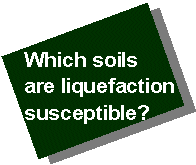
|

|
|
Criteria |
|
There are a number of different ways to evaluate the liquefaction susceptibility of a soil deposit. Here they are organized as follows (adopted from Kramer, 1996). |
|
Historical Criteria Observations from earlier earthquakes provide a great deal of information about the liquefaction susceptibility of certain types of soils and sites. Soils that have liquefied in the past can liquefy again in future earthquakes. If you are building a house and want to find out if your site is susceptible to liquefaction, you could investigate previous earthquakes to see if they caused liquefaction at your site. Information is also available in the form of maps of areas where liquefaction has occurred in the past and/or is expected to occur in the future (Dept. Conserv., Div Mines & Geol., California). Many local government agencies have prepared maps of sensitive areas, including areas susceptible to liquefaction. Check with your local building department or public library. |
|
Geological Criteria The type of geologic process that created a soil deposit has a strong influence on its liquefaction susceptibility. Saturated soil deposits that have been created by sedimentation in rivers and lakes (fluvial or alluvial deposits), deposition of debris or eroded material (colluvial deposits), or deposits formed by wind action (aeolian deposits) can be very liquefaction susceptible. These processes sort particles into uniform grain sizes and deposit them in loose state which tend to densify when shaken by earthquakes. The tendency for densification leads to increasing pore water pressure and decreasing strength. Man-made soil deposits, particularly those created by the process of hydraulic filling, may also be susceptible to liquefaction. For more details read, why liquefaction occurs. |
|
Compositional Criteria Liquefaction susceptibility depends on the soil type. Clayey soil, particularly sensitive soils, may exhibit strain-softening behavior similar to that of liquefied soil, but do no liquefy in the same manner as sandy soils are. Soils composed of particles that are all about the same size are more susceptible to liquefaction than soils with a wide range of particle sizes. In a soil with many different size particles, the small particles tend to fill in the voids between the bigger particles thereby reducing the tendency for densification and porewater pressure development when shaken. The geologic process described above produce rounded particles. The friction between angular particles is higher than between rounded particles, hence a soil deposit with angular particles is normally stronger and less susceptible to liquefaction. More about compositional criteria. |
|
State Criteria The initial "state" of a soil is defined by its density and effective stress at the time it is subjected to rapid loading. At a given effective stress level, looser soils are more susceptible to liquefaction than dense soils. For a given density, soils at high effective stresses are generally more susceptible to liquefaction than soils at low effective stresses. For a more complete explanation, continue to More about State Criteria |

|
|
|
Home
|
What
|
When
|
Where
|
Why
|
How
| | Research | Links | |